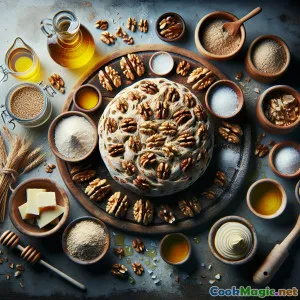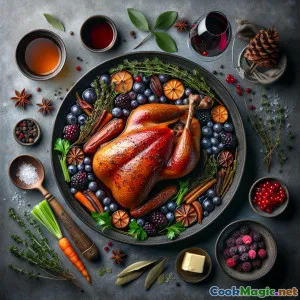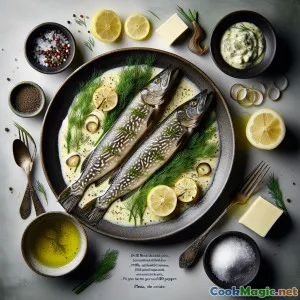
翡翠波德哈莱黑麦核桃乡村面包
(Emerald Podhale Rye & Walnut Country Bread)
(0 评论)食材
营养
- 份量: 8
- 每份大小: 1/8 个面包(约75 g)
- Calories: 224 kcal
- Carbohydrates: 39 g
- Protein: 6 g
- Fat: 5 g
- Fiber: 4 g
- Sugar: 2 g
- Sodium: 295 mg
- Cholesterol: 0 mg
- Calcium: 22 mg
- Iron: 1.4 mg
制作步骤
-
1 - 激活酵母:
将酵母和蜂蜜(如使用)混入温水。静置10分钟,直到起泡。
-
2 - 混合干料:
在一个大碗中,将黑麦粉、面包粉、盐和葛缕子籽(如使用)混合。
-
3 - 成型面团:
将酵母混合物和橄榄油(如使用)倒在干燥材料上。用结实的勺子搅拌直到混合均匀。
-
4 - 加入核桃,揉面:
拌入核桃。将面团放在略撒粉的工作台上,揉至光滑(7–10分钟)。
-
5 - 第一次发酵:
把面团放入抹油的碗中。盖上,放在不通风的地方发酵,直到体积膨胀到原来的两倍左右(约2小时)。
-
6 - 成形与二次发酵:
排气后把面团整成圆形面包坯。放在烘焙纸上或在撒粉的发酵篮中。盖上盖子,让其继续发酵至蓬松,大约1.5小时。
-
7 - 预热烤箱:
在最后发酵阶段,将烤箱预热至230°C(446°F),并在烤箱内放入一口铸铁锅。
-
8 - 划纹并烘焙:
将面团小心移入热的荷兰锅中;在表面撒上额外的面粉并划出花纹。盖上盖子烘烤35分钟,然后揭开盖子再烘烤10分钟,以形成深厚的外壳。
-
9 - 冷却并上菜:
将面包取出,在网架上冷却至少30分钟后再切片,以完成质地的发展。
将酵母和蜂蜜(如使用)混入温水。静置10分钟,直到起泡。
在一个大碗中,将黑麦粉、面包粉、盐和葛缕子籽(如使用)混合。
将酵母混合物和橄榄油(如使用)倒在干燥材料上。用结实的勺子搅拌直到混合均匀。
拌入核桃。将面团放在略撒粉的工作台上,揉至光滑(7–10分钟)。
把面团放入抹油的碗中。盖上,放在不通风的地方发酵,直到体积膨胀到原来的两倍左右(约2小时)。
排气后把面团整成圆形面包坯。放在烘焙纸上或在撒粉的发酵篮中。盖上盖子,让其继续发酵至蓬松,大约1.5小时。
在最后发酵阶段,将烤箱预热至230°C(446°F),并在烤箱内放入一口铸铁锅。
将面团小心移入热的荷兰锅中;在表面撒上额外的面粉并划出花纹。盖上盖子烘烤35分钟,然后揭开盖子再烘烤10分钟,以形成深厚的外壳。
将面包取出,在网架上冷却至少30分钟后再切片,以完成质地的发展。
关于 翡翠波德哈莱黑麦核桃乡村面包 :的更多信息
Introduction
Podhale Rye and Walnut Rustic Bread is a tribute to rustic Eastern European country loaves, inspired by the earthy harvests and simple but profound home baking traditions of the Podhale region in southern Poland. This bread encapsulates Old World culinary wisdom—a time when bread was nourishment, centerpiece, and pride for rural families across Polish highlands.
The heady aroma of rye, pulsing with nutty sweetness from walnuts and a brush of caraway, harkens back to bread you’d encounter in mountain village markets or alongside cheese and mushroom stews shared at timber-clad inns. What makes this recipe unique is its blend of rich rye with wheat, providing an accessible crumb for modern bakers without losing Old Country character. The addition of walnuts not only amplifies texture but harnesses Podhale’s tradition of foraging for nuts and herbs.
Tips, Notes & Substitutions
- Flour: Always use the best-quality rye flour you can get; stone-ground gives an authentic, earthy taste and solid nutrition. In a pinch, dark rye can be blended with all-purpose, but ratios may need tweaking as rye absorbs more moisture.
- Nuts: Walnuts should be coarsely chopped; their visiting crunch provides dynamic mouthfeel in each bite. If walnuts aren’t available, hazelnuts (common to Carpathia) are a tasty substitute.
- Crust: For an extra crisp, crackly crust, bake the bread in a pre-heated Dutch oven and leave the lid off for the final 10 minutes for deeper color—and a mesmerizing aroma.
- Salt & Sweeteners: Finer salt disperses better; honey isn’t vital but disguises the sometimes-acidic rye and boosts browning. Maple syrup lends a smoky undertone.
- Caraway: While optional, caraway is time-honored in Central European rye loaves and lends an unmistakeable tingle and deformal bread-smell many Eastern Europeans associate with home.
History & Cultural Significance
In the foothills of the Tatra mountains, bread is more than a daily bake. Once a way of life for highlanders—shepherds, cheese makers, artisans—the Podhale region’s dark breads fueled their hard, windy, communal living. Grain had to be stretched; supplements like mashed potato, seeds, and sometimes whatever orchard windfall (namely walnuts) could enrich sparse cupboards. Sundays and harvest feasts still see loaves cross icons and prayer candlelight, a centerpiece of gratitude and togetherness.
This take on the Podhale loaf is a blend of tradition and modern comfort—combining enough wheat flour for a soft crumb with distinct rye tang, then adding encased, roasted walnuts that offer unexpected excitement as you slice through.
Personal Thoughts & Serving Ideas
This bread, while sublime warm and buttered, reaches its zenith when paired with smoked cheese (try Oscypek), thick honey, or cold mountain trout pâtés. Leftover slices transform into hearty toast or grids of rye-and-walnut salads. In winter, I love it next to borscht; in summer, simply torn apart under alpine wildflower meadows.
What’s magical is how the nuts caramelize as the bread bakes, scenting the crust and giving a depth not found in mass-produced loaves. It’s as deeply nested in Polish tradition as it is friendly to modern, health-focused kitchens that value fiber, ancient grains, their slow nutrition, and their careful stories.
Final Note
Bake this bread not just for its taste, but because its aroma alone can unite friends and neighbors for comfort and good talks. Both simple and sophisticated, the Podhale Rye and Walnut Rustic Bread invites you to slow down and savor.
























